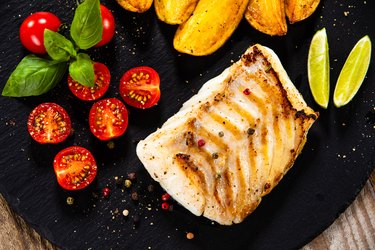
Not to be confused with the cartoon character, the John Dory is a deep-sea fish favored by chefs for its mild taste and ability to blend well with ingredients. The best way to cook your John Dory fillet may depend on your personal preference, as this fish can be grilled, poached or pan-fried.
Read more: Healthy Lunch Fish Tacos
Video of the Day
Video of the Day
What Is the John Dory?
Sometimes referred to as St. Peter or St. Pierre, the John Dory fish is a round, flat fish with a distinct dark spot on its side said to be the thumbprint of St. Peter. The dark spot, however, serves as a means of protection for the deep-sea dwelling fish by confusing potential predators.
The olive-colored fish has an unusually large head with long spines that jut out of its dorsal fin. The John Dory fish doesn't usually grow larger than 2 feet or weigh more than 7 pounds. It's also primarily found in the coastal areas of Europe, some parts of Asia, Africa, Australia and New Zealand.
You may have a difficult time finding John Dory fillet on the menu at your favorite restaurant in the United States because it's not native to the coastal waters. However, the fish is sometimes shipped in. If you're lucky and spot it on a menu or at your local seafood market, you'll enjoy the sweet, mild and moist John Dory flavor.
John Dory Fillet Nutrition
Adding more fish to your diet is good for your health. The American Heart Association and the Dietary Guidelines for Americans recommend that adults eat two servings of fish a week or about 8 ounces total. Fish tends to be low in calories and fat and a good source of protein and other essential vitamins and minerals.
Despite the recommendations, Americans aren't meeting their weekly fish recommendations, according to the Office of Disease Prevention and Health Promotion. There are many factors that may be inhibiting fish consumption in the U.S., including taste preferences, uncertainty about preparation and mercury levels.
Fish contain mercury in varying amounts, and it's a common source of the heavy metal in the diet. In high amounts, mercury is toxic and can damage your nervous system. The Food and Drug Administration recommends that pregnant and breastfeeding women consume fish with low levels of mercury. According to New Zealand Food Safety, the John Dory fillet is low in mercury, and intake isn't restricted during pregnancy.
Read more: 7 Fish Recipes That Are Great for Your Heart
John Dory Cooking
The mild John Dory taste makes it a popular fish choice among chefs because it can be prepared in many ways and pairs well with many ingredients and flavorings. You can grill, poach or pan-fry your John Dory fillet.
On the grill, first season your John Dory fillet with salt, pepper and olive oil. Then cook on a preheated grill over medium-high heat for 10 minutes per inch of thickness or until the fish reaches an internal temperature of 145 degrees Fahrenheit. Serve with grilled zucchini, yellow squash and onions.
Poaching is a great way to infuse flavor into the mild-flavored Dory fish. Fill a large saute pan with 1 inch of water, then add slices of lemon and sprigs of fresh parsley. Bring your water to a boil and add a pinch of salt. Reduce to a simmer and add your John Dory fillets (boneless) and poach based on the thickness of your fish.
The James Beard Foundation recommends poaching your dory fish recipe for five minutes for a 1/2-inch-thick John Dory fillet. Serve with rice and our simple recipe for Steamed Asparagus with Grated Parmesan.
Pan-fried John Dory fish may be the most popular preparation method, but it may not be the healthiest. To add more nutrition to your dish, use whole-wheat flour or whole-grain breadcrumbs or make our recipe for Chia Seed Crusted Fish.
After your fish is properly coated, heat oil in a large skillet over medium heat. Add your fillets and cook until the coating is a golden brown and the flesh is opaque, about two to three minutes per side for a 1/2-inch-thick fillet. To lighten the meal, serve with mixed greens or our tangy Cucumber Salad.
- Oceana: "John Dory"
- American Heart Association: "Fish and Omega-3 Fatty Acids"
- Health.gov: "Dietary Guidelines for Americans, 2015-2020: Appendix 3. USDA Food Patterns: Healthy U.S.-Style Eating Pattern"
- Office of Disease Prevention and Health Promotion: "Five Strategies for Encouraging Seafood Consumption: What Health Professionals Need to Know"
- Food and Drug Administration: "Advice About Eating Fish"
- New Zealand Food Safety: "List of Safe Food in Pregnancy"
- USDA Food Safety and Inspection Service: "Safe Minimum Internal Temperature Chart"
- James Beard Foundation: "White-Wine Poached Fish"
- Gulf of Maine Research Institute: "American John Dory"
- Washington State Department of Health: "Healthy Fish Recipes"